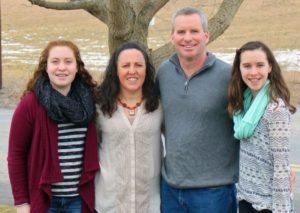
AGRICULTURE ORAL HISTORY INTERVIEWS
ROBERT O’TOOLE
Dobbs Rd
Northeast Madison Township
Interviewed by Jane Hoover February 8, 2016
Bob’s grandfather moved to this farm in 1946 and bought it several years later. Bob’s parents, Frank and Carol, and his uncle Mike succeeded them and, in 1994, Bob returned home to the farm from college. In 2001, Bob started buying his dad and uncle out and took over management of the farm. Bob’s wife Stacy teaches school.
The first thing one notices upon driving up the O’Toole lane is how compact and neat everything is. Several interested calves watch over the doors of their hutches and about ten dry cows look up from munching hay in their loose housing shed. Behind them is a large bank barn with several additions, three silos and a large manure pit off to the side. Bob ushers me in the barn and directly into the milking area. A large computerized machine fills half the room and from it extends an arm holding an array of equipment, not unlike the arm and tray in a dentist office. The equipment is partially hiding a cow on the other side of the partition. All I can see of her is her legs from the knees down and her udder. She is standing quietly while the machine whirrs and moves around under her belly.
The cow has walked into the milking station on her own and she is standing quietly, eating a high-energy pelleted mix. As she entered the stall, the robot read her tag number electronically and displayed it on a screen. It knows from her history approximately where she will stand and where her teats will be. The equipment brushes each teat with what looks like soft bottle brushes. Little puffs of air dry off the teats. Then the four teat cups attach to her teats. When she is finished milking, the machine squirts disinfectant on each teat. The milk will be transported from the cow to the weigh jar through four plastic 5/8 inch tubes attached along the robotic arm. But first the milk from each teat is tested by the computer for color, temperature and electrical conductivity. These tests reveal whether or not she might have mastitis, which would make the milk unacceptable. Assuming all is good, which it usually is, the cow is milked, the milk goes into a chilled holding tank and all aspects of her visit, including her production, are recorded in the computer. The gate opens, she leaves and the next cow enters.
The robotic milker operates 24/7. Consequently, one could visit the milking area in the middle of the night and see the robot hard at work. Cows come in to be milked when they are hungry for the pellets, on average 2.9 times a day. Cow numbers have been static now for 8 or 10 years, but production per cow and per hour of labor have continued to increase. The herd averages 25,500 pounds of milk per cow per year right now, whereas the county average is around 21,500 pounds.
From the observation room, we walk around the corner and into the free stall barn which houses 60 cows. The stalls are elevated about eight inches above an alley for the manure. The stalls themselves stay clean and dry. They are covered with cushioned mattresses and chopped straw. Some cows sleep, some stick their heads through the bars to eat their forage, others wander down the alley toward the milking station. In the alley, a heavy chain slowly pulls a scraper toward the other end of the building. It passes about once every two hours to keep the alley clean. Large fans whir in the background. Bob tells me that each cow exhales three to four gallons of water every day, so ventilation is essential. Cows are most productive when temperatures are around 50 degrees, a difficult target in the summertime. An evaporative cooling system with tunnel ventilation can lower summertime air temperatures in the barn from 5 to 20 degrees. Evaporation converts liquid water to water vapor. It takes energy to evaporate water and as water evaporates the air is cooled.
The key to the system’s efficiency is the software Bob can access on his phone, giving him up-to-the minute information on the operation of the robot and its computer, the milking performance of his cows and real-time surveillance of the cows in the barn. Not only can he watch cows entering and leaving the milking station, but he can keep an eye on cows in loose pens who are close to giving birth. Cows like consistency and regular schedules, but now Bob has the freedom to keep tabs on them while doing other farm work or attending school functions with his teenage daughters.
JANE: How many cows did you have when you started out?
FRANK: When we started to milk with my dad and mom, we were milking by hand. We had 12 cows, as I remember. I was 7 years old. I don’t know how long that went on. Then we advanced to the milking machines, and had in the neighborhood of 20 cows. We were milking in the old barn, There were several additions over the years. One was when we went to a bulk tank from milk cans in 1967. We had to carry our milk in bucket milkers to a strainer before it went into the bulk tank. My mom did most of the carrying. My dad was a carpenter and he worked away during the daytime. Finally my brother and I took over the dairy.
BOB: Dad’s brother Mike was a partner here for years. He worked away as a milk tester, but spent a great deal of his time at the farm. Both milking and field work took a lot more time than they do now, so he was an important part of the operation. He moved to Blain when he was married in 1968. I helped a little through high school and started full time in 1994 after graduating from college.
JANE: Did you go to ag school?
BOB: Yes, I went to Delaware Valley College.
JANE: Tell us how you decided to transition from a pipeline milking system to what we see today?
BOB: Our feeding and cropping systems had improved over the years. In 1990 we had a pipeline in a tie stall barn. Then we installed a bigger and better pipeline along with automatic take-offs, but still in a tie stall barn. Our milking equipment hung from a track system so that we didn’t have to lift the weight.
CAROL: I don’t think that idea caught on very well, but it was a good system.
BOB: It was a good system and it’s improved a lot over the years. They use PVC now.
JANE: Have you always been interested in technology? How did you decide to investigate robotic milkers?
BOB: I guess you could say one aspect of our farm that has always interested me is doing less work; always looking for an easier way to do things. Sometimes you come to the decision that the way you are doing things is the best available option. We had updated our feeding system in such a manner that we no longer needed a lot of labor. Likewise with field work. We had transitioned from small square bales to chopping haylage and moving our feed around with machinery. Additionally, we had transitioned to 100% no till planting. It seemed that our milking system had reached a plateau. Then this idea came along.
The first time I looked at it, it didn’t seem like a realistic option for us. But when I revisited the idea a few years later, it did.
CAROL: He has something in his background he isn’t talking about. He grew up loving computers. He and three or four other kids at school took awards with their computer work.
BOB: I did have an interest, but I didn’t stay up with it. Even now, everything we do isn’t cutting edge. We’re mixing new and old technology. You don’t want to be the guy who’s the guinea pig. You want to adopt technology where you’re fairly sure that the things that don’t work out aren’t the big things. The first time I looked at the robotic technology, the only ones available to look at in the US seemed to be in special situations, not on the family farms. After five or ten years, I found US farmers who had been using the technology for several years. Foreign countries had adopted this technology way ahead of us. It’s a machinery vs. labor issue. The one thing the US has is Hispanic laborers who milk over 50% of the cows in the US. But as time passes, that is changing. All of agriculture is moving toward more automation. Even orchards and produce are developing robotic pickers.
JANE: For you it looked like a good option.
BOB: It is very difficult to find labor. Most farms, when they make a major change, they are getting bigger, taking on debt or getting more people involved. But our dairy hasn’t grown for a number of years, while our family and labor situation has changed over the years. In 1950, the family had six people plus the parents and everybody helped at the farm. It’s evolved to where my children and wife don’t help on the farm on a daily basis. My dad is working full time, but is slowing down somewhat. Bringing people in part time to help milk didn’t work out for us. To hire a full time employee might cost $50,000 when you include health insurance, retirement, etc. and when you need to be competitive with other employers. As important as agriculture is to our area, there are very few people who are not either family members or Hispanics working at local dairies.
JANE: So it was really a way of survival to you?
BOB: Yes, and also some of the appeal to me was that I was hoping I would have more flexibility in my family life.
JANE: What do you see in your future?
BOB: It would seem like the number one concern is to do well with what we have. Number two would be to keep trying to find ways to improve in every area. The improvements I see in the near future seem gradual. What we have now is good, so where do we go from here? Some of the advances you see in cars, for example, how big are they? Most of them are in the infotainment area. Nothing like going from carburetors to fuel injection.
What would precipitate a radical change is if there were a new generation down the road, and I don’t know that yet. But I want to have the land, the technology, the cows, the finances in such a position that the next generation could build on what we have in place and successfully proceed forward. A 60 cow/single robot operation with 160 tillable acres can be successful. If another generation joins me, we might double the operation to 120 cows and two robots. Add some more acreage. You don’t have to be enormous to be successful, at least not in Pennsylvania.
